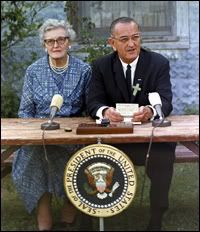Elementary and Secondary Education Act Became Stronger Than Ever After 40 Years

President Lyndon B. Johnson with his childhood teacher Kate Deadrich Loney in the signing of the 1965 Elementary and Secondary Education Act.
How would Lyndon B. Johnson, the man who helped turned the Elementary and Secondary Education Act (ESEA) 0f 1965 into a law during his presidential term, react to the No Child Left Behind Act? In honor of the ESEA's 40th anniversery (I assume), Education Week's website features an article about how Johnson's law became as colossal as it is today.
Enjoy this brief timeline which shows how the ESEA evolve over the years:
1965: President Lyndon B. Johnson signs the Elementary and Secondary Education Act, ushering in a major expansion of the federal role in schools. The centerpiece of the new law is the Title I program for disadvantaged students.
1968: Congress expands the ESEA with new programs and titles, including programs for migrant children, neglected or delinquent children, and the Bilingual Education Act.
1970: In response to widespread reports of misused federal funds, the law is changed to clamp down on how Title I aid is spent. The legislation, signed by President Richard M. Nixon, adds demands that the federal aid “supplement, not supplant” money spent by states and localities, and that Title I schools receive state and local aid “comparable” to that received by other schools in the state.
1978: In a reauthorization signed by President Jimmy Carter, Title I aid for the first time can be spent “schoolwide” if at least 75 percent of children in the school are eligible for the aid.
1981: President Ronald Reagan pushes hard for a rewrite of the law consolidating many programs into a block grant, though the reauthorization main-tains Title I—renamed Chapter 1—as a separate program. It also reduces regulatory and paperwork requirements for states and districts. This reauthorization ushered in a period of depressed spending under the federal law.
1985: The Supreme Court, on a 5-4 vote in Aguilar v. Felton, rules that the practice of sending public school teachers into religious schools violates the First Amendment’s ban on government establishment of religion. As a result, students from religious schools must travel to mobile vans, public schools, or other neutral sites to receive Title I services.
1988: The law takes important steps toward the kind of student testing and accountability later expanded upon. Districts must annually assess, based on standardized-test scores, the effectiveness of Chapter 1 programs in schools. Program improvement plans are required for each school that does not make substantial progress toward raising student achievement.
1994: President Bill Clinton signs the Improving America’s Schools Act, a reauthorization of the ESEA that requires states to develop standards and aligned assessments for all students. Districts also must identify schools not making “adequate yearly progress” and take steps to improve them, though the law is far less strict than the 2001 version in defining AYP and applying consequences to schools that don’t make it.
1997: The Supreme Court, on a 5-4 vote in Agostini v. Felton, overturns its 1985 ruling by deciding that the U.S. Constitution does not prohibit school districts from sending teachers into religious schools to provide Title I ser-vices to needy students.
2002: President George W. Bush signs the No Child Left Behind Act of 2001, which expands the ESEA’s testing requirements and introduces an aggres-sive federal role in holding states and school districts accountable for showing improved student performance. It also requires all public school classrooms to have “highly qualified” teachers.


0 Comments:
Post a Comment
<< Home